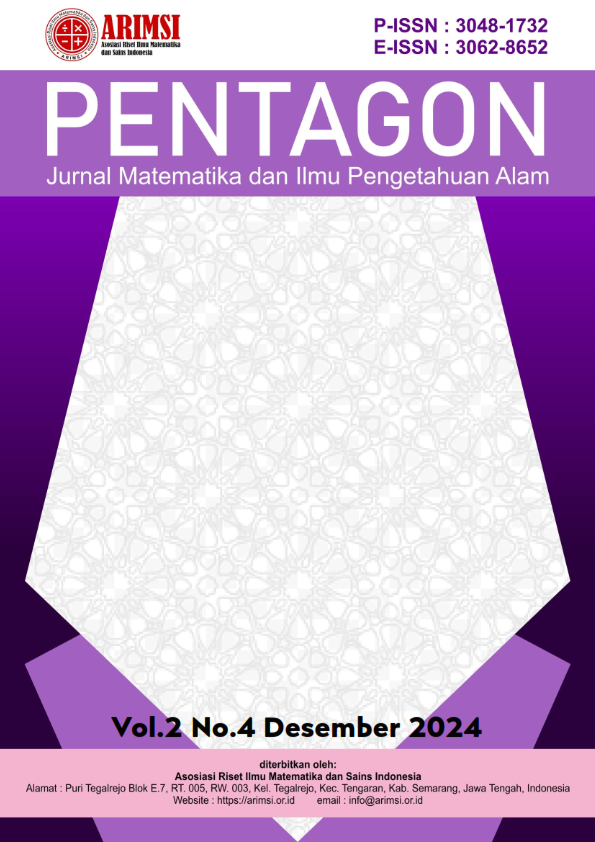Kajian Literatur Evolusi Kuda: Perubahan Kaki Dan Perubahan Gigi Kuda Berdasarkan Penemuan Fosil
DOI:
https://doi.org/10.62383/pentagon.v2i4.364Keywords:
Evolution, fossils, horses, adaptationAbstract
Evolution is characterized by changes over time with one or more inherited traits that we often find in populations of organisms. Fossils themselves can be said to be traces/remains/marks of a life of an organism (animal/plant) that can be directly or indirectly preserved with the earth's crust, naturally occurring and usually solid/hard with a geological age of more than 11,000 years. Horse evolution is one of the interesting adaptations, with morphological changes related to environmental changes. The purpose of this study was to determine the evolution of horses from the fossils found and, to find out how to adapt and the changes that occur from the environment and factors of natural selection. The method used in this study is a literature review from several reference sources. Horse evolution shows how species can adapt to the environment through significant morphological changes, such as a reduction in the number of fingers and an increase in body size. and the role of natural selection in forming physical characteristics that support survival.
Downloads
References
Ayu, N., & Niken, N. (2020). Evolusi mamalia, manusia dan tumbuhan. Palu: Universitas Tadulako.
Borkent, D., Reardon, R. J. M., McLachlan, G., et al. (2016). An epidemiological survey on the prevalence of equine peripheral dental caries in the United Kingdom and possible risk factors for its development. Equine Veterinary Journal Online. https://doi.org/10.1111/evj.12610
Dixon, P. M., Froydenlund, T., Luiti, T., et al. (2015). Empyema of the nasal conchal bulla as a cause of chronic unilateral nasal discharge in the horse. Equine Veterinary Journal, 47(4), 445–449.
Ferry, J., et al. (2019). Pengetahuan mahasiswa Institut Agama Islam Negeri Kerinci tentang teori asal usul manusia. Bioeduca: Journal of Biology Education, 1(1), 12–17.
Janis, C. M., & Bernor, R. L. (2019). The evolution of equid monodactyly: A review including a new hypothesis. Frontiers in Ecology and Evolution, 7, 119.
Jeninarto, J. (2014). Gagasan evolusi makhluk hidup: Sebuah tinjauan ringkas dan refleksi. Jurnal Filsafat, 24(2), 134–147.
Kennedy, R. S., & Dixon, P. M. (2016). The aetiopathogenesis of equine periodontal disease – A fresh perspective. Equine Veterinary Education. https://doi.org/10.1111/eve.12563
MacFadden, B. J., & Pirie, S. (2014). Equine dental evolution: Perspectives from the fossil record. In J. Easley, P. M. Dixon, & J. Schumacher (Eds.), Equine dentistry (3rd ed., pp. 3–10). Edinburgh, UK: Saunders Elsevier.
Marshall, R., Shaw, D. J., Dixon, P. M., & Istvan, G. (2014). A study of sub-occlusal secondary dentine thickness in overgrown equine cheek teeth. Veterinary Journal, 193(1), 53–57.
Martin, P. D. (2017). Evolusi kuda dan evolusi kedokteran gigi kuda. Kuliah Terkini Frank. J. Milne. Prosiding AAEP, 63.
McHorse, B. K., Biewener, A. A., & Pierce, S. E. (2017). Mechanics of evolutionary digit reduction in fossil horses (Equidae). Proceedings of the Royal Society B: Biological Sciences, 284(1861), 20171174.
McHorse, B. K., Biewener, A. A., & Pierce, S. E. (2019). The evolution of a single toe in horses: Causes, consequences, and the way forward. Integrative and Comparative Biology, 59(3), 638–655.
Muhammad, L. T. (2019). Teori evolusi Darwin: Dulu, kini, dan nanti. Jurnal Filsafat Indonesia, 2(3), 98–102.
Nuruzzaman, et al. (2019). Geologi. Yogyakarta: Uin Sunan Kalijaga Yogyakarta.
Rose, K. D., Holbrook, L. T., Rana, R. S., Kumar, K., Jones, K. E., Ahrens, H. E., et al. (2014). Early Eocene fossils suggest that the mammalian order Perissodactyla originated in India. Nature Communications, 5(1), 5570.
Solounias, N., Danowitz, M., Stachtiaris, E., Khurana, A., Araim, M., Sayegh, M., & Natale, J. (2018). The evolution and anatomy of the horse manus with an emphasis on digit reduction. Royal Society Open Science, 5(1), 171782.
Suly, S., et al. (2017). Potensi sumber daya alam fosil kayu di daerah Gorontalo. Jurnal Pengelolaan Sumberdaya Alam dan Lingkungan, 7(2), 172–177.
Suske, A., Pöschke, A., Schrock, P., et al. (2016). Infundibula of equine maxillary cheek teeth: Part 2: Morphological variations and pathological changes. Veterinary Journal, 209, 66–73.
Downloads
Published
How to Cite
Issue
Section
License
Copyright (c) 2024 Pentagon : Jurnal Matematika dan Ilmu Pengetahuan Alam

This work is licensed under a Creative Commons Attribution-ShareAlike 4.0 International License.





